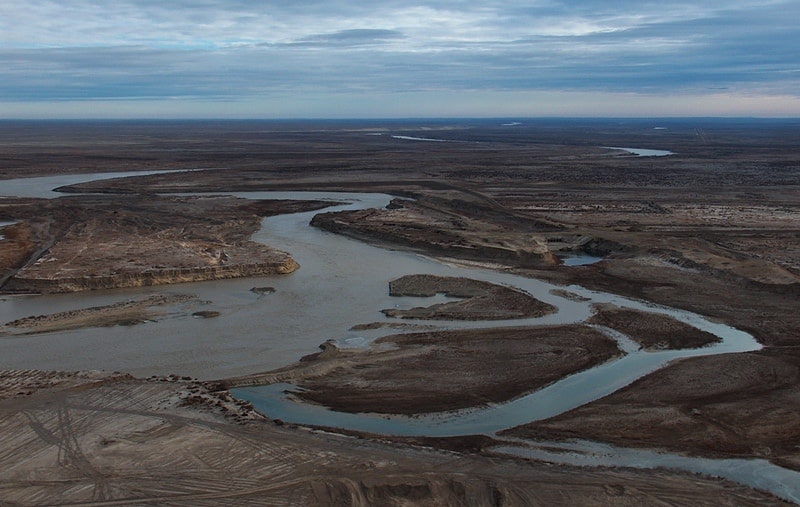You are here
The Sarykamysh lake.




Birding Tours in Uzbekistan.
“Nature encourages no looseness, pardons no errors”
Ralph Waldo Emerson.
Bird Watching Tours in Uzbekistan.
Sarykamysh is a drainless saline lake located in the central part of the Sarykamysh depression, approximately midway between the Caspian and Aral seas. This is a cross-border area. The northern deep-water part of the lake (about 1,000 square kilometers) is located in Uzbekistan, the central and southern (about 3,000 square kilometers) - in Turkmenistan.
The lake appeared in 1963 as a result of the discharge of collector drainage water into the Sarykamysh depression along the ancient bed of the Amu-Darya - Daryalyk canal. Along the western and northeastern shores of the lake there are cliffs of the southeastern Ustyurt with a height of about 100 meters, steeply descending to the lake.
The main components of its rocks are rocky stony, sometimes limestone and gypsum. Over the entire length (more than 20 kilometers), the chink has only 3 ravines of the gorge connecting the plateau with the Sarykamysh hollow.
The vegetation is present only under cliff: it is extremely poor and is represented by saltworts, wormwood, and rare bushes of saxaul. The main factors of anthropogenic impact on this site are roads and fishing. There are no permanent settlements in this area, land is not used for pastures, and no mineral resources are being developed.
However, the presence of a person (fishermen) creates a factor of concern, the laying of roads leads to the degradation of soil and vegetation.
Reptiles of Sarykamysh lake.
The survey was carried out in a narrow canyon of the eastern cliff. In general, the species diversity and numbers of reptiles here are high due to the good protective conditions of the area. However, due to lack of time, the fauna was not fully identified: twilight species (snakes, geckos) were not taken into account.
A total of 3 species of reptiles were identified at this site: the Central Asian tortoise, the steppe agama, and the rapid foot-and-mouth disease. The population of the steppe agama was 1.3 individuals per hectare, of the rapid foot-and-mouth disease - 5.3 individuals per hectare.
Mammals of Sarykamysh lake.
A deep canyon overlooking the cliff and further the edge of the cliff were surveyed. Residential colonies of the great gerbil, located on the edges of the canyon and having different exposures, and single holes of the common mole-ram are found here.
The number of gerbil was 0.52 individuals per hectare, the habitability of colonies - 40%. The number of the blindfly was 0.25 individuals per hectare. In this area, a large number of individual trails of gazelle and trails of these animals are noted.
The approximate number of these animals in the vicinity of the northern half of Lake Sarykamysh, located within Uzbekistan - 40 - 60 individuals. Traces of the fox, eared hedgehog. In the Eastern Cliff in the vicinity of the Sudochye system of lakes and Sarykamysh lake and the cliff zone, 10 species of reptiles and 13 species of mammals were recorded.
The total list, taking into account literature data, includes 1 species of amphibians and 14 species of reptiles, which makes up 50% of the fauna noted for Ustyurt as a whole. Of these, one species is listed in the National Red Book (Palassa snake) and IUCN international red lists (Central Asian tortoise).
The list of mammals includes 29 species, which, in turn, makes up 65% of the fauna of Ustyurt, but the list of bats is incomplete and needs to be improved. 3 species are listed in the Red Book of Uzbekistan and 13 in the international red lists of IUCN.
The jerboa of Severtsov is a regional endemic. A key representative of the mammals of the Ustyurt Plateau is the saiga. Small populations are found throughout Ustyurt throughout the year, but the bulk of the animals are kept in the northern part of the plateau, including the Eastern Chink and the cliff zone
On Ustyurt there is a typical inhabitant of clayey and gravelly deserts - Severtsov's jerboa; a small jerboa dwells in the biyrgun and wormwood grass plants. The latter is the most numerous and widespread species.
A yellow ground squirrel, a large gerbil, and a common heifer were noted. The other widespread and numerous representatives of the Ustyurt fauna are the hare and the big-eared hedgehog. In the cliff tugai and on the cliff in the vicinity of the lake Sudochye there is a boar, the number of which has increased in recent years.

Authority:Bykova E. A. “Fauna of terrestrial vertebrates of the Eastern Chinka plateau Ustyurt”. E. A. Bykova, A. V. Esipov, D. E. Golovtsov, D. A. Nurizhanov. Bulletin of Tyumen State University. Ecology and nature management. 2017. Volume 3. Number 4. ttps://vestnik.utmn.ru
Photos by
Alexander Petrov.







